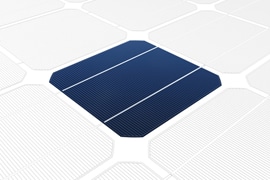
Photovoltaics Solar Cells
Photovoltaics Solar Cells Produce Solar Electricity
![]() Solar Power can be thought of as “Solar Electricity” and the key to generating solar power is the “solar cell”, or more precisely the “Photovoltaic Solar Cell”. Solar power is one of the most viable and cleanest forms of renewable energy because we can use the suns energy within the sunlight to produce electricity by means of photovoltaics.
Solar Power can be thought of as “Solar Electricity” and the key to generating solar power is the “solar cell”, or more precisely the “Photovoltaic Solar Cell”. Solar power is one of the most viable and cleanest forms of renewable energy because we can use the suns energy within the sunlight to produce electricity by means of photovoltaics.
The solar cell operates according to what is called the photovoltaic effect, where “photo” means light and “voltaic” means electricity. Solar cells are more technically called Photovoltaic Solar Cells, Photovoltaics or simply PV’s.
Photovoltaics are silicon semiconductor devices similar in many ways to electronic diodes and transistors. Photovoltaics produce electricity by converting the solar energy generated from the sun in the form of either visible light, ultra-violet (UV) radiation or infra-red (IR) radiation into a direct or DC current by using the photovoltaic action of the cell without the use of any moving parts.
Sunlight is clean, easy to harness and is freely available worldwide with the only cost involved being in the cost of a solar photovoltaic panel itself, making solar power an ideal choice for local home electricity generation.
Solar electricity is also very environmentally friendly, as it produces no pollution or waste by-products, no air or water pollution, and is completely silent making it ideal for a greener future. One of the most commonest types of photovoltaic solar cell is made of specially treated silicon semiconductor, and is therefore known as a silicon photovoltaic solar cell.
Converting Sunlight into Electrical Power
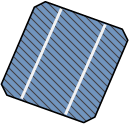
Photovoltaic Solar Cell
Generation of solar power begins with the photovoltaic solar cell. Photovoltaic (PV) cells are semiconductor devices made from wafers of highly purified silicon ( Si ) doped with special impurities giving them an abundance of either “electrons” and “holes” within their lattice structure.
Solar cells convert sunlight energy into an electric current, they do not store energy, but they can be thought of as a small battery producing a fixed output voltage of about 0.5 to 0.6 volts depending upon the type.
Photovoltaic solar cells produce a variable output DC current that is proportional to their size and the amount of solar radiation falling upon the silicon wafer. Being silicon semiconductor devices they consist of a positive P-type layer and a negative N-type layer joined together to form a “PN-junction” very similar to that of the PN junction diode.
The photovoltaic solar cell is made from silicon crystals. Silicon crystal atoms have four electrons in their outermost orbital. These four electrons are shared with neighbouring silicon atoms to form full orbital’s of eight electrons creating a stable atomic structure. When sunlight hits the silicon material, electrons are “knocked” from their orbital and become “free electrons”. Because the electrons in the silicon crystalline material only become free when exposed to light, it is therefore called a semiconductor.
In other words, exposing silicon to light causes its electrons to become mobile or free. But simply exposing a semiconductor to light is not enough to extract an electric current from it, to do that we need to create “positive” and “negative” poles within the silicon allowing electrons and therefore a current to flow in and out of the silicon material.
Photovoltaic Solar Cell N-type Semiconductors
In order for our silicon crystal to conduct electricity, we need to introduce an impurity atom such as Phosphorus (P) into the crystalline structure making it extrinsic ( impurities are added ). Phosphorus atoms have five outer electrons in their outermost orbital to share with neighbouring atoms and are commonly called "Pentavalent" ( 5-electron ) impurities. This allows four out of the five orbital electrons to bond with its neighbouring silicon atoms leaving one "free electron" to floating around the doped crystal.
When exposed to sunlight, the electrons freed from the silicon atoms are quickly replaced by the free electrons available from the doped Phosphorus atoms (electron flow). But this action still leaves an extra electron (the freed electron) floating around the doped crystal making it negatively charged. Then a semiconductor material is classed as N-type when it has an excess of electrons thereby creating a negative pole. As each impurity atom “donates” one electron, pentavalent atoms are generally known as “donors”.
Photovoltaic Solar Cell P-Type Semiconductors
If we go the other way, and introduce a "Trivalent" ( 3-electron ) impurity into the crystalline structure, such as Boron (B), which has only five electrons arranged in three shells around its nucleus with the outermost orbital having only three electrons, the fourth closed bond cannot be formed. Therefore, a complete stable connection is not possible, giving the semiconductor material an abundance of positively charged carriers known as "holes" in the structure of the crystal where electrons are effectively missing.
As there is now a hole in the silicon crystal, a neighbouring electron is attracted to it and will try to move into the hole to fill it. However, the electron filling the hole leaves another hole behind it as it moves.
This in turn attracts another electron which in turn creates another hole behind it, and so forth giving the appearance that the holes are moving as a positive charge through the semiconductor crystal structure. This movement of holes represents conventional current flow.
The movement of holes results in a shortage of electrons in the silicon turning the entire doped crystal into a positive pole. Therefore, a P-type semiconductor material has more holes than electrons and as each impurity atom generates a hole, trivalent impurities are generally known as “Acceptors” as they are continually “accepting” extra or free electrons.
The PN Junction
On their own, both N-type and P-type semiconductor materials are electrically neutral, but when these two semiconductor materials are first brought together some of the free electrons move across the junction to fill up the holes in the P-type material producing negative ions, but because the electrons have moved they leave behind positive ions on the negative N-side and the holes move across the junction in the opposite direction into the region where there are large numbers of free electrons. This movement of electrons and holes across the junction is known as diffusion.
This process continues until the number of electrons which have crossed the junction have a large enough electrical charge to repel or prevent any more carriers from crossing the junction. Eventually a state of equilibrium (electrically neutral situation) will occur producing a “Potential Barrier” zone around the area of the junction as the donor atoms repel the holes and the acceptor atoms repel the electrons. Since no free charge carriers can rest in a position where there is a potential barrier it is therefore “depleted” of any free mobile carriers, and this area around the junction is now called the Depletion Layer.
The significance of this built-in potential is that it opposes both the flow of holes and electrons across the junction and is why it is called the potential barrier. Sunlight is electromagnetic radiation consisting of very small units of light energy called photons.
When a photon in the form of sunlight hits or strikes the PN-junction of the solar cells semiconductor material, the energy from the photon dislodges or knocks loose any free electrons within this PN-junction as they become excited by the photons energy. This results in the electrons being released and able to move freely across the depletion layer leaving in its place a hole or a positive charge.
In the P-type material, these free electrons easily cross through the depletion layer and into the N-type material, but this movement of electrons is one-way, as the electrons are not able to cross the depletion layer back into the P-type material. As a result, an excess of free electrons builds up in the N-type semiconductor material creating an electrical current within the solar cell and will continue indefinitely as long as there is exposure to sunlight.
As positive and negative sides of the junction are now created, the photovoltaic solar cell acts as a type of battery producing both a voltage and a DC current. Then a photovoltaic cells turn photons into electrons in the form of an electric current. Small wires or metal ribs are connected to both the P-type and N-type semiconductor materials to harness this newly created energy producing solar power in the form of a DC current flow as shown below.
Photovoltaics Solar Cell Construction
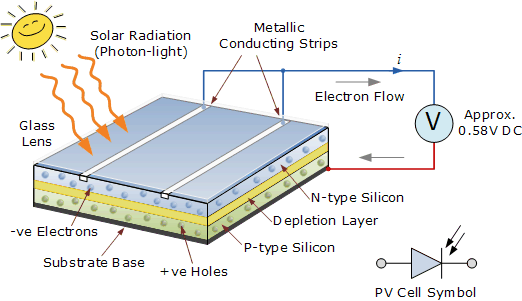
Solar Power from the Sun
The silicon wafer of the photovoltaic solar cell facing the sun consist of the electrical contacts and is coated with an anti-reflective coating that helps absorb the sunlight efficiently. The electrical contacts provide the connection between the semiconductor material and the external electrical load, such as a light bulb or battery.
When sunlight shines on a PV cell, photons of light strike the surface of semiconductor material and liberate electrons from the materials atom structure. Certain doping chemicals are added to the semiconductors composition to help to establish a path of the freed electrons.
This creates a flow of electrons forming an electrical current which starts to flow over the surface of the photovoltaic solar cell. Metallic strips are placed across the surface of the photovoltaic cell to collect these electrons which forms the positive connection.
The back of the PV cell, the side away from the incoming sunlight, consists of a layer of aluminium or molybdenum metal which forms the negative connection to the cell. Then a photovoltaic solar cell has two electrical connections for conventional current flow, one positive, and one negative.
The type of solar power produced by a photovoltaic solar cell is called direct current or DC the same as from a battery. Most photovoltaic solar cells produce a “no load” open circuit voltage (nothing connected to it) of about 0.5 to 0.6 volts when there is no external circuit connected. This output voltage ( VOUT ) depends very much on the load current ( I ) demands of the PV cell.
For example on very cloudy or dull day the current demand would be low and so the cell could provide the full output voltage, VOUT but at a reduced output current. But as the current demand of the load increases a brighter light (solar radiation) is needed at the junction to maintain a full output voltage, VOUT.
However, there is a physical limit to the maximum current that a single photovoltaic solar cell can provide no matter how intense or bright the suns radiation is. This is called the maximum deliverable current and is symbolised as IMAX.
The IMAX value of a single photovoltaic solar cell depends upon the size or surface area of the cell (especially the PN-junction), the amount of direct sunlight hitting the cell, its efficiency of converting this solar power into a current and of course the type of semiconductor material that the cell is manufactured from either silicon, gallium arsenide, cadmium sulphide, cadmium telluride etc.
Photovoltaic Formula For Power
Most commercially available photovoltaic solar cells have solar power ratings which indicate the maximum deliverable solar power, PMAX that the cell can provide in watts and is equal to the product of the cell voltage (V) multiplied by the maximum cell current (I). This is given as:
Where: W is in Watts, V is in Volts, and I is in Amperes
Photovoltaics Solar Cell Example No1
Calculate the maximum output current of a single 0.5v silicon photovoltaic cell with a maximum rated power output of 1.75 Watts at full sun.
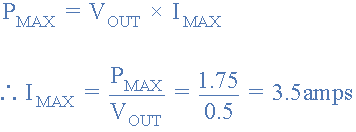
Note that this is the maximum theoretical current as the true or real current is determined by the rate of the incoming solar photons. The amount of electrical power generated by a photovoltaic cell depends on the amount of solar irradiance and other conditions such as the surrounding or ambient temperature as well as cloud cover. The power rating of a photovoltaic cell, expressed in watts (W), is the maximum or peak power that a cell can deliver at full sun with the PV cell uncovered. Lets try another example.
Photovoltaic Solar Cell Example No2
At full sun a 0.58 volt photovoltaic solar cell produces an output current of 1.73 amperes. Calculate the maximum power output of the photovoltaic cell in watts.

Various manufacturers refer to a photovoltaic solar cells output power at full sun as its: “maximum output power”, “peak power”, “rated power”, “maximum power point” or other such terms but they all mean the same.
As we have said before, standard sunlight conditions on a clear day at the equator at midday are assumed to give an irradiance of 1,000 watts of solar energy per square meter (1000 W/m2 or 1kW/m2) and this is generally referred to as a “Full Sun” condition. That is maximum irradiance onto the photovoltaics surface.
Less than full sun will reduce the current output of the cell by a proportional amount. For example, if only one-half of the suns energy (500 W/m2) is available, the amount of output current is roughly cut in half because the solar cell only has half the brightness to generate electricity.
Manufacturers of the photovoltaic solar cells produce current-voltage (I-V) curves as shown below which gives the current and voltage at which the photovoltaic cell generates the maximum power output and are based on the cell being under standard conditions of sunlight and temperature with no shading.
Photovoltaic Solar Cell I-V Characteristics
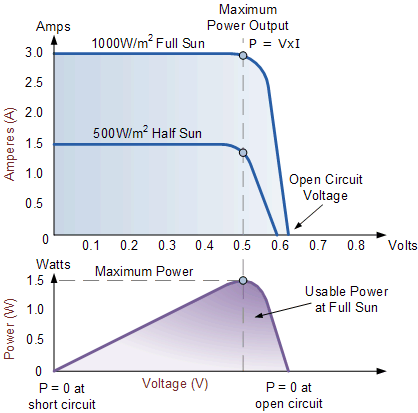
The power available from a photovoltaic solar cell at any point along the curve is expressed in watts and is calculated by multiplying the voltage times the current as we have seen above, watts = volts x amps. For maximum output power from a cell the face of the photovoltaic should be pointed as straight toward the sun as possible.
So to produce more electrical power from a photovoltaic solar cell we need to either increase the photovoltaic effect, the energy of photons, or produce a different type of cell that is more efficient at converting the solar energy into electricity. At the present time, most commercial photovoltaic solar cells are manufactured from silicon, the same material from which sand is made.
In the next tutorial about “Solar Power”, we will look at the different Types of Photovoltaic Cells available as well as their construction and solar efficiencies.











This post was really informative! I had a basic understanding of photovoltaic solar cells, but your explanation made the technology much clearer. I’m particularly interested in learning more about the environmental benefits and advancements in efficiency. Thanks for sharing!
“The amount of electrical power generated by a photovoltaic cell depends on solar irradiance and other conditions such as temperature and cloud cover”
The term “temperature” is it refers to the ambient temperature? How does it affect the power generated by a solar PV?
Unlike solar thermal panels which require the thermodynamics of the Sun’s high temperatures to heat water (or some other liquid), the temperature of the surroundings (or the ambient temperature) affects the performance of photovoltaic solar panels.
Photovoltaic (PV) solar panels convert the photon energy of solar radiation (sunlight) into DC electricity based on the photovoltaic effect. The electrical performance of a photovoltaic cell or panel is given by it current-voltage (I-V) curve. However, this I-V curve varies with solar radiation and device temperature.
The electrical performance of a PV panel is rated at Standard Test Conditions (STC) with an irradiance of: 1,000 W/m2 at a panel temperature of: 25oC. Increasing a panels temperature results in a decrease in open-circuit voltage and power, but can cause a small increase in current.
Thus a PV panels temperature coefficient relates the effects of changing a PV panel (or cell) temperature on voltage, current and power as a panel operating at say: 60oC will generate less power. Likewise, a PV panel operating at temperaures less than STC (say: -10oC) will increase power output proprtionally depending on its temperature coefficient.
Then for maximum power generation, photovoltaic solar panels require low temperature clear skies ensuring a constant source of sunlight such as those found during the winter months. During the hot summer months, temperature affects the output of a PV panel (or cell) and high temperatures must not be assumed to provide high irradiation levels from a cloudless sky.
Thanks for the detailed explanation of photovoltaics and solar cells! I never knew that photovoltaic solar panels could produce both direct and alternating current. It’s fascinating to learn about the technology behind renewable energy sources. I’m looking forward to implementing this knowledge to reduce my carbon footprint.
cite from the article:
“In the P-type material, these free electrons easily cross through the depletion layer and into the N-type material, but this movement of electrons is one-way, as the electrons are not able to cross the depletion layer back into the P-type material. As a result, an excess of free electrons builds up in the N-type semiconductor material creating an electrical current within the solar cell and will continue indefinitely as long as there is exposure to sunlight.”
Questions:
1. Why the electrons can only move in one way from P-type to N-type in the PN-junction but not the other way around? Because the reason why PN junction is formed is the electric field formed at the PN junction stopped electrons to move from N-type to P-type anymore. If the electrons got enough energy, why couldn’t it keep moving to P type but the other way around?
2. How can we create an infinite current if the electrons which caused the current are from PN junction? what will happen if all the electrons moved away from PN junction? in this case, whether the PN junction will be formed again bc of the density difference of electrons and holes from N-type and P-type, which means, the PN junction can never disappear so infinite current is possible?(of course it’s under normal condition, if you impose a big reversed voltage on the PN junction, it will damage it)
The operation of a PN-junction is best explained by considering the movement of holes and electrons in the depletion layer. A PN-junction is formed when contact is made between a P-type and an N-type semiconductor material as holes and electrons from each side diffuse across the junction. This is because electrons enter the N-region where there is a large number of holes, and holes move across the junction in the opposite direction to the P-region where there is a large number of free electrons. This creates a state of equilibrium on both sides across the junction called the depletion layer.
Positively charged donor atoms and negatively charged acceptors become fixed within the depletion layer establishing an electric field (about 0.5V) across it. Thus preventing the movement across the junction unless they have sufficient energy to overcome the newly formed potential barrier. When a supply of energy, for example light energy (irradiance) hits and penetrates into a the semiconductor junction, the light photons transfer their energy to an electron knocking it from the depletion layer. The electric field allows the movement of electrons and holes to their respective collection areas for movement around a closed-circuit. Thus as long as light photons keep hitting the PN-junction, electrons will flow. Obviously in low-light dark conditions there are no light photons so the cell’s PN-junction is quiescent.
It is interesting the exchange that happen between electrons and holes left behind in creation of n and p-type of semiconductors. Indeed power is directly dependent on Output voltage as this dictates the amount of energy generated
At Pmax, is Vout = Vmax? Does Vmax correspond to maximum current?
Vmax means Maximum Voltage as “V” stands for Voltage, not current. Maximum Current would be Imax. For a photovoltaic cell, Pmax occcurs at the maximum power point.
Working in the solar filed for 7 years now. This is the best article I have read explaining solar cells. Thanks. I am studying courses now to better my knowledge on PV systems.
How about the recycling of solar panels. Hear more and more that it is not possible?
Hello,
As we know that PV cells generate a fixed amount of current. But what if we don’t need that much current as produced by a cell. Current should be dependent on load. Is it so in this case OR Will that extra current is wasted?
A PV cells current output is determined by the connected load up to its maximum Isc
what are the different current equivalent value of diferent luminance in pv cells
Please consult the manufactures datasheet for the IV-curves of your solar panel
This is so informative and interesting post about solar power. Thanks for posting with us.
Knowledge full article
I just have one question- can intensity of the light source affect the cell???
without light intensity, a pv cell can not generate electricity
I like the article- it gives me a lot of information. But one question- can heat affect a solar cell???
Heat reduces cell efficiency
thanks.
its a very flourish material
awesome article, really helped me understand solar cells . Keep it up 🙂
Thanks for a remarkable article. I am happy to read such an pleasing blog post after a long time.
I agree with your post. Energy from the sun is clean, Reading this has really help me learn some needed information about the solar cell. thanks